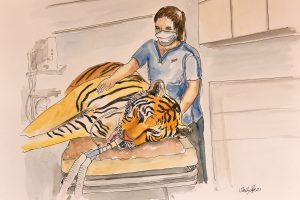Ethically challenging situations in animal care during COVID-19
The global pandemic has had a profound impact on people, animals and the environment. Veterinarians and allied animal health workers faced unique challenges, such as having to relinquish personal protective equipment, ventilators (and sometimes even staff) to human health care, and balancing public, client, personal and staff safety with animal welfare in an everchanging environment.
Frequency, Stressfulness and Type of Ethically Challenging Situations Encountered by Veterinary Team Members During the COVID-19 Pandemic by Anne Quain, Siobhan Mullan, Paul D McGreevy and Michael P Ward, published in Frontiers in Veterinary Science (April 2021, Volume 8) analyses the results of the largest global survey on ethically challenging situations (ECS) encountered by veterinary team members.
Previous studies have identified that veterinarians experience a high rate of ECS at work, so it is not surprising that the survey found the median frequency of ECS increased from several times per month to several times per week. It is, however, extremely important to acknowledge the issue and gain a deeper understanding of the situations and to learn from them.
The study found the most common ECS were deciding how to proceed when clients have limited finances; managing the conflict between personal wellbeing and professional role; and managing conflicts between the interests of clients and the interests of their animals.
While situations such as a client’s capacity or willingness to pay are not new ethical challenges, pet owners were not immune from the economic impact of the pandemic, and restrictions on practice operations left clinics with reduced income, adding to the stress of this ECS.
Trying to manage the safety and wellbeing of clients and their animals, as well as themselves, their colleagues and families presented veterinary professionals with enormous practical and ethical challenges. ‘Non-contact’ consultations were widely adopted Covid-safety strategies. However, providing veterinary services to animals in the absence of their owners can potentially cause distress and fear in the animal, with consequent risk to the safety of the treating team, as well as upsetting the owner. This ECS is poignantly described in the study with a quote from an Australian veterinarian who observed “in the case of very sick animals/emergencies/euthanasia owners are distressed about not being able to be with their animal. Do you cave and let them be there knowing that if you get covid19 the entire clinic team and possibly other clients could get infected, or stick to the policy knowing you are causing emotional distress to the owner and animal?”

That this veterinarian’s concerns are focused so strongly on others says much about their compassion as an individual and reflects Cat Protection’s experience of the compassion shown by the broader veterinary community.
ECS can cause moral stress and impact significantly on mental health. All stakeholders – not only the veterinary sector, but pet owners, animal welfare organisations, government, and the community at large – have a role to play in reducing the burden and risk of ECS faced by veterinary team members, and each other.
This paper provides a point-in-time snapshot of the impact of a global pandemic on veterinary teams as well as offering insights into opportunities for further investigation and policy development to support the brave and talented people who make it their vocation to be there for animals, and for the people who love them.
The pandemic presented ECS for Cat Protection also: how to manage staff, volunteer, client, veterinarian and public safety while maintaining continuity of care for our cats and continuing to pursue our mission. We made decisions that cost us financially, such as hiring additional staff to create unique teams.
While we had (and have) in place strict infection control measures, we still needed to risk manage the potential event that even one case of actual or suspected COVID-19 infection would require that person and every one of their close contacts to be absent for 14 days. Apart from the obvious fact that we wanted to minimise risk to people, if we rostered mixed personnel across shifts it could have led to almost no staff being available to provide direct cat care. Thus, applying a practical ethical framework meant choosing to draw down on savings (a future financial risk) in order to mitigate against the immediate risks to the health, safety and wellbeing of cats currently in our care.
One of our risk-management strategies, adoptions by appointment-only, revealed an unanticipated benefit: our cats were more relaxed due to meeting fewer strangers every day. When cats are less stressed, they are not only happier but less likely to become ill.
In stressful situations such as the pandemic it can be hard to see any advantages but with observation and analysis, there can be positive lessons to learn.
The full article and supplementary material (including survey respondents’ free-text comments) are open access, so free for anyone interested to read and download. Cat Protection shared the survey on our Facebook page: if you were one of the vets or vet nurses who responded, thank you for contributing to this valuable research.





